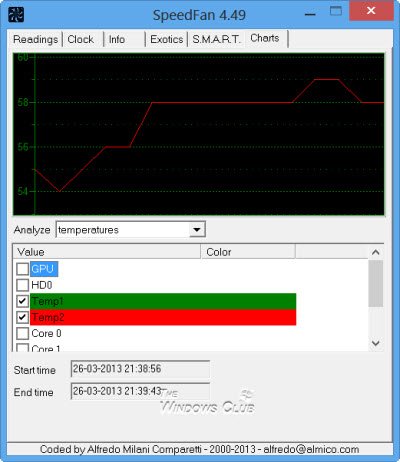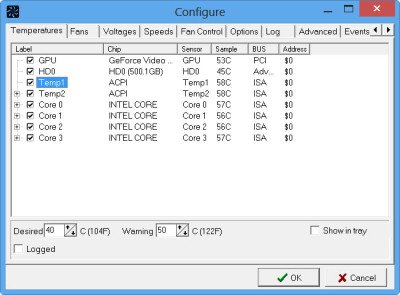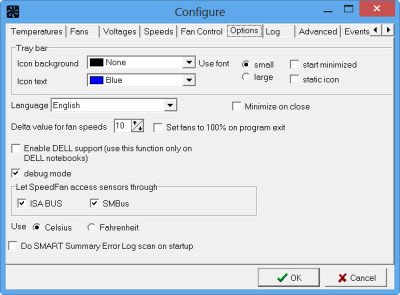I work on a laptop, and I think that it needs some serious tuning up with the fan. It spins very fast every few minutes and also is very loud. While looking for some options to control the temperature of my computer system, I decided to check out SpeedFan. It is a powerful software that can read voltages, temperatures, and the fan speed of your computer.
Monitor voltage, fan speeds & temperatures using SpeedFan for Windows 11/10
SpeedFan changes the computer system’s fan speed according to various components’ temperature. The program checks the temperature of the system components through the digital temperature sensors and changes the fan speed accordingly. The program works with hardware monitor chips and also shows the hard disk temperatures via S.M.A.R.T info. Besides its feature to show the temperatures inside my Motherboard, CPU, and HDDs, this program also automates the cooling cycles of my machine.

SpeedFan has many functions and after using, it for my system, I decided to summarize some of its important points here in my post.
- When you start SpeedFan, you notice a checkbox for “Automatic Fan Speed” in the program window. I first thought that just checking this would be enough to manage my system’s fan speed, but I was wrong; things were not that easy with SpeedFan. Well, I checked it, but I didn’t notice any change in my machine’s fan speed.
- One very important thing to consider before you start with the SpeedFan is that this program is not guaranteed to work well with all motherboards, thus, check your motherboard compatibility before you start with it. You can check your motherboard compatibility HERE.
- To start the program working on your system, you must first configure it. Click on the tab “Configure” on the main window of SpeedFan. Here, you will see a few labels and chips. The main job of SpeedFan is to check the temperature via the temperature sensors inside your machine, and these labels show that the fan speed should vary according to the chip and sensor they are associated with.
- In the configuration window, you might notice the blocks asking for “Desired” and “Warning”, here you need to configure the threshold temperatures for your machine. Set the desired temperature to the value SpeedFan should aim for. When your machine attains the desired temperature, the SpeedFan program will start dropping the fan speeds, and if the temperature of your machine is more than the desired temperature, the program will automatically increase the fan speed. When your system temperature reaches the maximum value, the software sets the fan speed to maximum. Don’t forget to check the box for “Automatically Variated.”
- Next, navigate to the “Options” tab and click on the checkbox saying “Set fans to 100% on program exit” and set “Delta value for fan speeds” to 99. If you want to rename any label, press F2 key.
- Now click on the tab “Advanced” and select your motherboard from the dropdown menu of SuperIO Chip. From the list of items in the dropdown menu, select the PWM control. Make sure that you select the right motherboard, as by setting the wrong motherboard or the wrong clock, you might hurt your system.
When done with configuring all the settings of SpeedFan, make a shortcut of the program to the desktop and make it run whenever you start your machine.
Read: How to check, control, increase, monitor, or change the CPU Fan Speed.
SpeedFan download
It works fine with Windows 11/10. You can download it from its home page.
SpeedFan is a powerful tool for advanced users. Your Windows computer’s hardware and software settings should be left at their defaults, but if you feel the need to monitor voltage, fan speeds, and temperatures, you may use SpeedFan. Remember, you should know what you are doing because making the wrong changes could have an adverse effect on your system.
TIP: Open Hardware Monitor is a portable free, open-source application that monitors temperature sensors, fan speeds, voltages, load and clock speeds of your Windows computer.
More free CPU Temperature Monitor and Checker software here.

